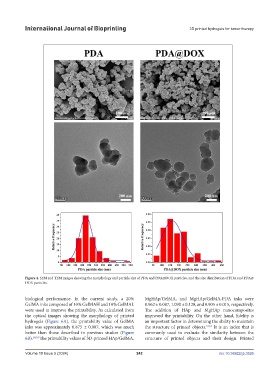Page 250 - IJB-10-5
P. 250
International Journal of Bioprinting 3D printed hydrogels for tumor therapy
Figure 4. SEM and TEM images showing the morphology and particle size of PDA and PDA@DOX particles, and the size distribution of PDA and PDA@
DOX particles.
biological performance. In the current study, a 20% MgHAp/GelMA, and MgHAp/GelMA-PDA inks were
GelMA inks composed of 10% GelMAH and 10% GelMAL 0.962 ± 0.087, 1.090 ± 0.128, and 0.905 ± 0.015, respectively.
were used to improve the printability. As calculated from The addition of HAp and MgHAp nanocomposites
the optical images showing the morphology of printed improved the printability. On the other hand, fidelity is
hydrogels (Figure 6A), the printability value of GelMA an important factor in determining the ability to maintain
inks was approximately 0.875 ± 0.007, which was much the structure of printed objects. 53,54 It is an index that is
better than those described in previous studies (Figure commonly used to evaluate the similarity between the
6B). 24,52 The printability values of 3D-printed HAp/GelMA, structure of printed objects and their design. Printed
Volume 10 Issue 5 (2024) 242 doi: 10.36922/ijb.3526

